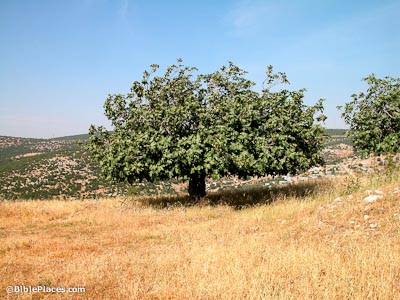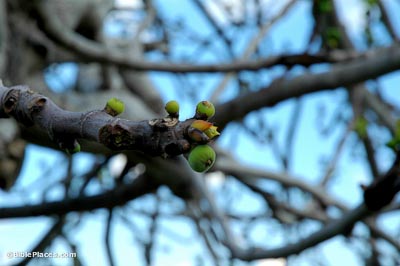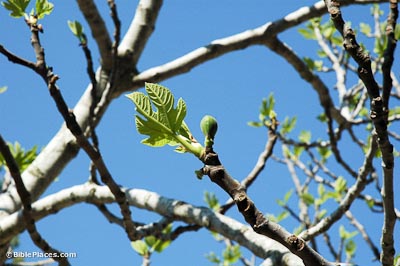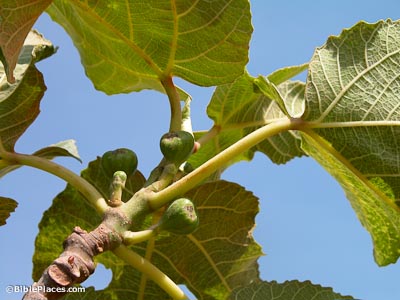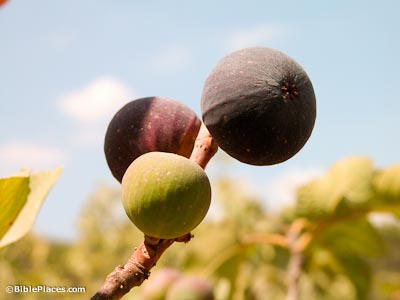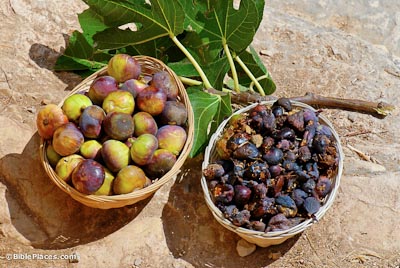Growing to nearly 20 feet (6 m) in height and with large leaves, the fig tree provides pleasant shade. Minute wasps cultivate these trees, and the fig is produced before the leaves emerge. The flower of the tree is never seen, as its many tiny flowers are housed within the fruit bud. Two crops are produced each year. The first crop is eaten fresh, while the second crop is dried for winter.
Fig Trees
An Image of Prosperity and Judgment
Mentioned over fifty times in Scripture, the fig tree was extremely important for both nutritional and economic reasons in ancient times. When things were well in Israel and the people prosperous, the Bible describes “every man sitting under his own fig tree” (1 Kgs 4:25). The prophets on the other hand, when predicting judgment on Israel, speak of the fig trees being destroyed (Jer 5:17).
Fig Leaves for Covering
The first mention of a fruit tree by name in Scripture references the leaves of the fig tree, not the fruit. Adam and Eve sewed fig leaves together to hide their nakedness (Gen 3:7). The leaves are as large as a human hand and are hairy on the back side.
Figs in Canaan
Figs, common in the Middle East today, were cultivated in Canaan before the Israelites entered the land. They were one of the seven species listed among the produce of the land God would give Israel (Deut 8:8). The spies brought back samples of this fruit before Israel entered the land (Num 13:23). Figs are both cultivated and grow wild in the region.
Fig Trees in the Gospels
The gospels also frequently mention fig trees. Jesus cursed a fruitless fig tree along the road to Jerusalem. Both Jesus and James used the production of figs as an example that actions and words flow from the heart of a person (Luke 6:42-44; James 3:12). Finally, because the fig tree is the last tree to produce leaves and it does so right before summer, Jesus used it as an example of knowing that the end of the age was near when the signs came (Matt 24:32; Mark 13:28).
Good and Bad Figs
“After Jehoiachin son of Jehoiakim king of Judah and the officials, the craftsmen and the artisans of Judah were carried into exile from Jerusalem to Babylon by Nebuchadnezzar king of Babylon, the Lord showed me two baskets of figs placed in front of the temple of the Lord. One basket had very good figs, like those that ripen early; the other basket had very poor figs, so bad they could not be eaten” (Jer 24:1–2, NIV).

Download all of our Trees, Plants and Flowers photos!
$34.00 $49.99 FREE SHIPPING
Related Websites
Fig (KKL-JNF). An approachable overview of Israel’s figs from a Jewish perspective.
Common Fig (Old Dominion University). Another overview with some interesting facts about the cultivation of figs.
Ancient Figs of the Holy Land (Wayne’s Word). A long and heavily-illustrated page with lots of information. Not all of it will be helpful, but it’s worth a look for the images alone.
10 Types of Fig Trees (Happy DIY Home). Those interested in identifying different varieties of figs (or cultivating a tree of their own) will find this page useful.
An Ancient Technique for Ripening Sycomore Fruit in East-Mediterranean Countries (J. Galil). For anyone curious about a detailed description of fig cultivation, this article offers interesting information and illustrations.
